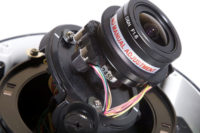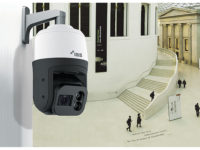When it comes to selecting the most appropriate IP megapixel camera for a particular customer or application, there are many considerations that must go into an integrator’s choice. Essentially, the camera has to match the requirements and needs while remaining conscious of customers’ budgets both today and in the future.
But which factors are the most likely to ensure you’re choosing the right camera for the right job? Conversations with several industry insiders reveal that there are, in fact, four primary points to consider: form factor, image resolution, lens and integration.
FORM FACTOR
When it comes to form factors, integrators have a wide variety of choices, but there are three main styles that cover the majority of those: Box, bullet and dome. Which style is right for an application depends mainly on what the end user wishes to accomplish, which isn’t always cut-and-dried.
“In a casino, you may want a big dome to be noticeable on the gaming floor but tiny domes to be less intrusive in the public areas,” says Mark Espenschied, director of marketing, Digital Watchdog, Cerritos, Calif. “In general, do you want the camera itself to be a deterrent to vandalism, or do you want your clientele to be unaware of the surveillance?”
All things being equal, most end users choose cameras based on the style they find most appealing in a space, says Sean Murphy, regional marketing manager, Bosch Security, Fairport, N.Y.
“For instance, museums tend to prefer equipment that blends into the environment to not distract from the art. On the other hand most banks and government locations prefer box or bullet cameras as a visual cue of the security level,” he says.
In the U.S. and Canada, the aesthetic factor has contributed to dome cameras’ position at the top of the heap. “Domes are still king,” says Nathan Dinning, product manager, March Networks, Ottawa. “They’re versatile and can be used indoors and outdoors, and they typically look quite nice as opposed to other styles. Plus, they’re also fairly easy to install. Putting more technology into a smaller form factor is a general trend in any technology, and we’re seeing that in security cameras.” (For a more on form factors, see “The Good, the Bad and the Ugly of Camera Form Factors” online at www.SDMmag.com/4-Ways-to-Get-the-Right-IP-Camera.)
As for material, obviously, the stronger, the better, particularly in areas where vandalism is likely to occur such as correctional institutions and subway stations.
“The best professional-grade surveillance cameras are cast metal rather than plastic found in many consumer or home use applications,” says Jeff Whitney, vice president of marketing, Arecont Vision, Glendale, Calif.
Security applications call for IP66 rating for weatherproofing as “dust tight” against dust, oil and other non-corrosive material to provide complete protection from contact with interior camera components. IK10 is the recommended shock-protection rating for most security cameras when a separate protective enclosure is not used. These standards are particularly important for cameras located within arm’s — or hammer’s — reach.
“This ensures that the camera — and bubble, if so equipped — is vandal-proof and able to withstand an external mechanical impact up to 20 joules of impact energy, or 55kg (120 pounds) of force,” Whitney says.
IMAGE RESOLUTION
While cameras continue to deliver higher and higher megapixel counts, those resolutions don’t always tell the whole story, says Doug Ringer, senior product manager, Pelco by Schneider Electric, Clovis, Calif.
“The proper way to measure resolution is using pixels on target. What details do you need to capture?” he says.
Specific purposes require specific pixel counts, says Jennifer Hackenburg, senior product marketing manager, Dahua Technology USA, Irvine, Calif.
“If very detailed images are required for identification of intricate information, it is best to specify a camera with enough resolution for 90 pixels per foot (PPF) or higher. Sixty pixels per foot will typically provide enough detail to identify a person’s features or the alphanumeric characters of a license plate. Thirty pixels per foot will provide general information of a scene,” she says.
One way to calculate pixel density is to divide the horizontal pixels of the intended camera’s resolution by the field of view for the application you are trying to cover. For a 4-megapixel camera with 2,688 horizontal pixels used to cover a parking lot with a 70-ft. field of view, pixel density would be approximately 38 PPF, Hackenburg says.
“This means a 4-megapixel camera for this application will provide enough resolution for general surveillance,” she explains. “Other factors that should also be considered when calculating pixel density, which may affect the clarity of the image, include lighting, lens quality, compression, and height of the camera.”
In determining the required pixels per foot, Whitney recommends using the U.S. Army’s DCRI (detection, classification, recognition and identification) scale as a rule of thumb. Under this standard, detection requires 20 pixels per foot (PPF), classification 40 PPF, recognition 60 PPF and 100 PPF for identification.
Sure, PPF is the best way to calculate required resolution, but it’s important to remember that this number depends on several other factors, including lenses, sensor, housing and more, Murphy says. “The challenge is that everything between the sensor in the camera and the target has an impact on the required resolution,” he says.
However, PPF cannot be calculated in a vacuum.
“Pixel density is something that has to be measured on-site,” says Ramy Ayad, senior product manager, Hanwha Techwin America, Ridgefield Park, N.J. “We have a tool that can calculate the pixel density of a camera given the view attributes.”
Of all the factors, however, field of view may be the most important for determining resolution.
“It really depends on the level of detail related to the field of view you want to cover,” says Ryan Zatolokin, chief technologist, Axis Communications, Chelmsford, Mass. “For instance, at a doorway where the field of view is not wide, you can use a lower-resolution camera and still get a usable image.”
Not surprisingly, higher-megapixel cameras are far from the sweet spot in the market in general. Nor are they always warranted, Ringer says.
“We’ve found that the vast majority of sales are 2-megapixel cameras, then 1-megapixel and 3-megapixel. Most of these cameras are capable of determining that a person is there, and in a lot of cases, they’re able to tell who it is,” he says.
A good way to think about using higher-megapixel cameras is to determine whether they may be needed in specific locations within a larger surveillance system.
“We encourage end users, depending on the application, to add resolution as needed, for example in high-importance zones,” Dinning says. “For higher-resolution cameras, they may use at least one at a main entrance to capture highly detailed images of people as they enter or exit, as well as one in the teller area where they deal with cash, while keeping lower-resolution cameras for general coverage.”
That’s not to say that 4K and other high resolutions don’t have their uses today.
“The place for 4K is where you need detailed images, such as where you want facial recognition to be able to tell what person is in row F, seat 5 at a stadium where there are only four cameras installed,” Ringer says. “4K allows you to zoom in 50 or 100 yards with enough detail to identify someone in a lineup.
LENS
A camera’s lens is often glossed over in the evaluation process, however this should actually be one of the most critical factors, Whitney says.
“A product data sheet may not convey that a less expensive camera uses a plastic lens instead of a quality glass optics package. This will impact image clarity, since a quality glass lens adds cost that low-cost cameras seek to leave out,” he says. “Plastic lenses also can degrade over time when exposed to the elements, and warp or otherwise decline in image quality due to constant heat and/or cold conditions. This condition typically won’t be revealed during trial or test, but can reduce camera image quality and require camera replacement over time.”
When you think about it, lenses shouldn’t be so overlooked given their role in determining a camera’s all-important field of view.
“In general, the length of the lens determines the field of view; it’s a gating factor,” Ringer says. “A larger lens means a shorter field of view — that’s just standard optical physics. The glass is better on more expensive lenses; it’s clearer and there are fewer distortions, especially when you look at how well it performs at the edge of the image. There can be wide variations on performance and distortions because of the properties of the lens, which is a factor of lens design.”
Lenses play a key role in determining field of view but they must be considered in relation to a camera’s imaging technology.
“Field of view is controlled mainly by the size of the imager and the lens used, so don’t let the millimeter length of the lens be the only indication of the field of view,” Ayad says. “You also need to consider the size of the sensor. Most manufacturers put in the field of view angle in the datasheet.”
While site surveys are a best practice for most integrators, there are still those who “wing it” when they get to a location, but not all lenses lend themselves to this seat-of-the-pants technique.
“A fixed focal length lens may be cheaper but you’re locked into one field of view,” Dinning says. “Therefore, a site survey is definitely recommended if you’re using a fixed focal length lens.”
As a result, the camera has a potentially limited range of coverage and must be selected carefully to ensure it is adequate to the end user’s requirements, Whitney says.
INTEGRATIONS
Finally, any camera should be certified for use with a wide range of video management systems (VMS) and NVR platforms rather than proprietary systems or equipment supplied by the manufacturer, Whitney says.
“This will allow the cameras to be used with any platform should the VMS/NVR be changed by the security department, or to take advantage of new features,” he says. “ONVIF Type S compliance is useful to ensure basic features of the camera can be supported by the selected VMS and/or NVR.”
Hackenburg adds, “A camera is just one element of a complete security solution: if it isn’t compatible with the rest of your system, it’s worthless.”
The best advice for specifying, evaluating and selecting IP megapixel cameras is to let the application and customer be your guide.
“There’s no need to ‘over spec’ a project,” Hackenburg says. “For simple applications, choose simple cameras, but don’t shy away from recommending cameras with more robust capabilities if there are features that are particularly well-suited for that application.”
Specialty Cameras
The traditional box, bullet and dome camera styles are most widely used for the vast majority of applications; but in some cases, they just don’t work — enter the specialty camera.
“Some applications like ATM, specific access points, or certain analytics — such as facial recognition — will require cameras to be located in places that require specialized form factors,” says Bosch Security’s Sean Murphy.
These purpose-built specialty cameras offer unique features that are not as widely used as general imaging, including thermal cameras or those with especially narrow application use, such as ultra-high megapixel ratings above 10MP per sensor, or a dual sensor-box camera with both WDR and low light capabilities, says Jeff Whitney of Arecont Vision.
“They are used uniquely for specific applications, while others may be for non-professional or home surveillance use,” he says.
An ATM camera, for example, requires very specific housing, mounts and field of view.
“You wouldn’t achieve the best results with a very small dome that just happened to fit in the available space; it’s not the same as a camera that’s purpose-built and designed for the application,” says Nathan Dinning of March Networks.
Another example would be mobile applications like transportation.
“For a camera mounted on a bus exterior, we offer a rugged HD wedge cameras that captures a little of the bus and at least two or three lanes on the other side,” Dinning says.
Easing Installation
Performance factors aside, the most important consideration for choosing IP megapixels is one that directly impacts integrators: ease of installation. After all, the longer it takes to deploy cameras, the less the installer makes on the project so it doesn’t make sense to choose state-of-the-art cameras that are labor-intensive to install.
At its most basic, the housing should be designed to reduce the required time and effort. According to Jeff Whitney of Arecont Vision, bullet and box cameras should be selected with an adjustable three-axle base that allows the camera to be deployed quickly and aimed to cover any angle. At minimum, he adds, dome and multi-sensor cameras should be as small and lightweight as possible while still getting the job done, but there are many other features these cameras offer that can further simplify installation.
Among these, Whitney says, are:
-
magnets to hold a dome camera in place while it is screwed down;
-
captive fasteners;
-
integrated tethers when appropriate to hold domes while the camera is installed;
-
remote focus/remote zoom allow the camera to be set up by pointing the entire unit or the individual sensors to cover the scene, then be remotely focused and/or zoomed for the exact view.
Remote setup is an additional option that the most advance cameras can offer.
“Install the camera, insert the IP cable, then dismount the ladder or lift and move the single or multiple sensors to cover the scene, then focus/zoom as necessary — all from a computer,” Whitney says.
Ease of installation can also impact camera counts and, by extension, costs.
“In general, the easier a camera is to install, or the fewer cameras that need to be installed, the less time it will take to complete the setup and maintain them down the road,” says Dahua Technology USA’s Jennifer Hackenburg. “For example, a camera with a motorized lens lets the installer or operator adjust the focus offsite as needed. A camera with a varifocal lens provides more flexibility during the specification process because you can wait until installation to adjust the lens according to the scene. A multi-sensor camera replaces multiple single-sensor cameras, meaning fewer cameras are needed for the same amount of coverage.”
For these reasons, PTZs can be more expensive to deploy.
“When it comes to PTZs, there is a lot more labor involved because they tend to be heavier and typically require more than one person to install,” Hackenburg says.
Because PoE has essentially become standard for ease of installation, integrators may wish to avoid those that don’t offer this capability, Whitney adds.
“Megapixel cameras, whether single- or multi-sensor, should require only a single PoE cable, rather than also requiring an electrical connection. This will save installation time and the cost of running electrical cabling,” he says.
Finally, says Mark Espenschied of Digital Watchdog, remember that less may actually be more. “When planning a system, consider how installing fewer high-resolution cameras can be more cost-effective than installing more low-resolution cameras,” he says.
The Good, the Bad and the Ugly of Camera Form Factors
Bullet
The smallest standard camera suitable for outdoor use without a protective enclosure, bullet cameras usually have an integrated adjustable mount, and many include remote focus, remote zoom and may also incorporate integrated IR LEDs. Bullet cameras typically offer lower cost and reduced size with features that vary from manufacturer to manufacturer. Housing is integrated into the camera, saving time and installation versus box cameras.
Box
Primarily niche cameras used outdoors with a tight enclosure or in very large indoor spaces, box cameras’ popularity is in significant decline. However, a key benefit of box cameras is the flexibility to use a number and variety of lenses.
Dome
Available in small/mini/micro and standard/larger models, dome cameras are used both indoors and outdoors. These cameras have become the top choice in the U.S. and Canada, primarily for their aesthetically pleasing and less obtrusive form factor. However, not all styles have every technical option available. For instance, domes commonly have a limited selection of lenses compared to equivalent box cameras, which can be a major challenge in smaller domes. Additionally, depending on the viewing angle, the camera and sensor (if adjustable) may need to be moved to ensure that the bubble doesn’t cause distortion to the view. In addition to packing a large number of features and capabilities into a relatively small format, dome cameras also tend to be easier and faster to install.





